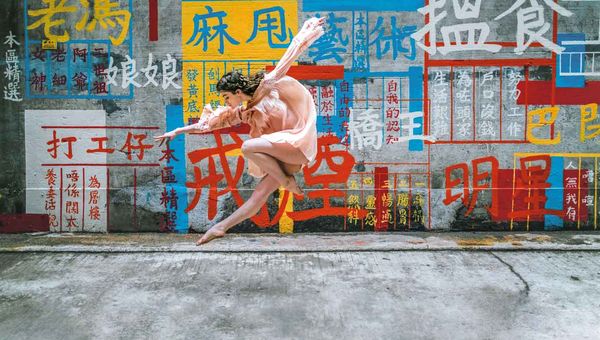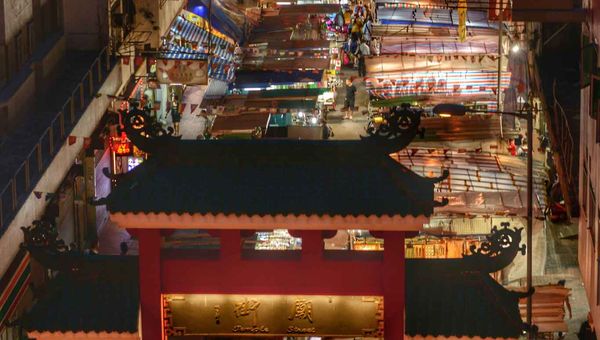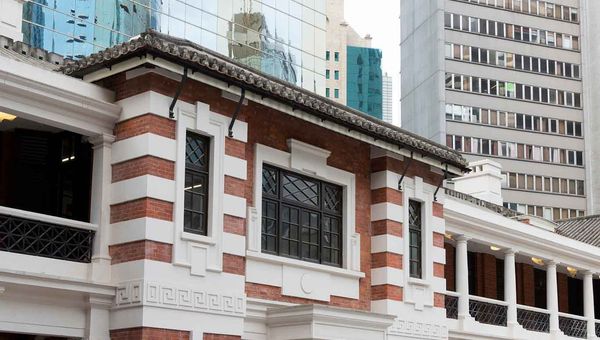Exploring Hong Kong’s multifaceted neighborhoods provides an intimate experience of the customs, rhythms and traditions of daily life.
The visitor’s first impression of Hong Kong will always be one of modernity – a business-like hustle and bustle on streets lined by towering office buildings. But those who venture beyond to explore less-visited neighborhoods soon discover the more intricate colors and hues of the tapestry that is Hong Kong.

Street Art
“Seeing the differences in the communities, learning about their schools, the different foods, the festivals – it’s very interesting. And the Hong Kong people are very embracing. They welcome you,” says Laudie Hanou, vice president of SITA World Tours.
West Kowloon: Creating New Traditions
One of the most dynamic areas to explore is West Kowloon, where the internationally acclaimed West Kowloon Cultural District and neighboring communities are creating fresh modern traditions.
The West Kowloon Cultural District is one of the world’s largest and most sophisticated arts and culture destinations. A dramatic highlight here is M+, an architecturally stunning contemporary art museum that has attracted global praise since opening in 2021. In addition to its 33 galleries showcasing 20th and 21st century Asian art, design and architecture, M+ offers shops, restaurants, a rooftop garden, cinema and live performances.
Another must-see in the Cultural District, especially for aficionados of Chinese art and culture, is the Palace Museum, which opened in summer 2022. More than 900 treasures from Beijing's Palace Museum are on display, including paintings, calligraphy, bronze, ceramics, jade, rare books, jewelry and costumes.
Another way to explore Chinese artistic culture is by taking in a performance at the nearby Xiqu Centre. The two-theater venue stages top-quality traditional Chinese opera and theater. Narrated performances of excerpts of Cantonese operas at the center’s Tea House Theatre are ideal for clients who are new to Chinese opera.
The West Kowloon Cultural District is at the heart of an evolving neighborhood that brings together living history, authentic local experiences, including dining, shopping and traditional artisanry, and a dynamic homegrown arts scene.
Of particular interest are Jordan and Yau Ma Tei, two adjacent communities just a short walk from the West Kowloon Cultural District, as well as neighboring Sham Shui Po.
Jordan
One of Hong Kong’s oldest neighborhoods, Jordan is a dense, historically working class community where 19th century buildings are tucked alongside apartment and office high-rises, and bright neon signs point the way to local shops.
Along Jordan’s narrow streets, you’ll find practitioners of traditional healing arts like Chinese herbal medicine and Feng Shui. Here too are workshops where artisans use old-school techniques to craft traditional items like embroidered cloth slippers, form-fitting qipao dresses and sandalwood incense.
Temple Street Night Market is a highlight. This bustling open-air bazaar springs to life in the evening, when shoppers haggle over prices at stalls overflowing with clothing, watches, souvenirs, tech accessories, knickknacks and more.
Yau Ma Tei
Like Jordan, Yau Ma Tei remains largely ungentrified, with lifelong residents frequenting its outdoor dai pai dong restaurants, and modest shops selling embroidery, tea, herbs, baked goods and more.
The Yau Ma Tei Wholesale Fruit Market, which dates to 1913, is true living history. A few blocks away, the huge Jade Market sells everything from souvenirs to top quality jade. On Shanghai Street, kitchenware shops sell handmade woks, bamboo steaming baskets, rice cookers and other specialty cookware, most at bargain prices.
Sham Shui Po
Nearby Sham Shui Po is another tight-knit community that provides an authentic local experience. Once the center of Hong Kong’s garment industry, Sham Shui Po today is home to active open-air street markets, a much-loved flea market, unexpectedly quirky shops, old-style restaurants, traditional temples and archetypal tong lau tenement buildings.

Temple Street Night Market
These days, Sham Shui Po is also attracting up-and-coming artists and entrepreneurs, giving rise to buzzy pop-ups and events, unique retail outlets, innovative startup businesses, chic coffee shops and initiatives focused on fostering community, collaboration and the arts. Among those worth a visit is Mudheytong Gallery, created by three local ceramic artists.
Sham Shui Po has many terrifically affordable places to eat. A few to try include: Hop Yik Tai, for rice noodle rolls; Kwan Kee Store, for steamed rice pudding; Lau Sum Kee, for fresh-from-scratch noodles; the Kakurega Ramen Factory, and Chung Kee Café, for milk tea.
Don’t let your clients miss one of Hong Kong’s most prized dim sum restaurants here – the Michelin-recommended Tim Ho Wan.
Old Town Central: Historic Hong Kong
On Hong Kong Island, Old Town Central is where the British first settled in 1841. Today, reminders of the past are all throughout this hilly neighborhood of gleaming skyscrapers.

Old Town Central Tai Kwun
Some of the most compelling attractions here fuse old and new. Among them, the award-winning Tai Kwun Centre for Heritage and Arts. A former police station, prison and magistrate’s office, this 170-year-old complex has been transformed into an arts and culture hub, with galleries, music, theater and exhibitions, plus superb restaurants and bars and heritage exhibits.
The most interesting way to reach Tai Kwun is via the Central-Mid-Levels Escalator, a unique mile-long system of covered escalators and moving sidewalks that ascends through the hills.
Another fusion of old and new in Old Town Central is PMQ, the former police married quarters (hence PMQ) of the Hollywood Road Police Force. Today the seven-story building houses more than 100 design studios and shops as well as bars, restaurants and cafes, plus live music and pop-up markets on weekends.
On Graham Street, there’s an open-air fresh produce, seafood and meat market that’s been in business for more than 160 years. Just a few blocks away is one of the city’s oldest temples, the picturesque Man Mo Temple. After taking a spiritual pause here, antiques shoppers can head just around the corner to Upper Lascar Row.